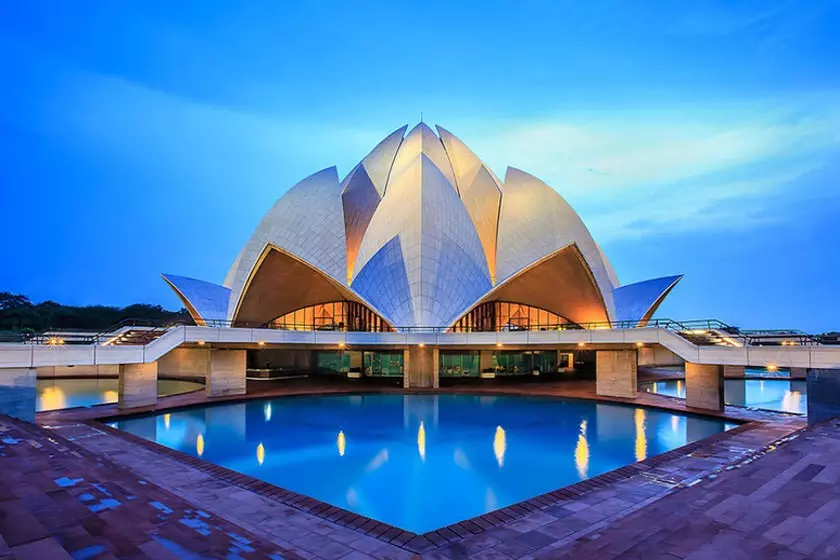
The Lotus Temple in Delhi, India, is a unique temple that is recognized as a symbol of harmony and unity across different religions and cultures. Shaped like a lotus flower, this temple is one of the most significant attractions in India, drawing attention with its extraordinary architecture. It is a Bahá’í House of Worship, where people of all faiths and beliefs are welcome to pray and meditate.
1. General Information
- Name: Lotus Temple
- Location: Delhi, India
- Architectural Style: Modern architecture, Organic design
- Opening Year: 1986
- Architect: Fariborz Sahba
- Function: Bahá’í House of Worship
- Shape: Lotus flower
- Number of Petals: 27 white petals
- Area: 27,000 square meters
2. Historical Background
The construction of the Lotus Temple began in 1953, when the Bahá’í Faith decided to build a central house of worship in India. The temple was officially opened in 1986, and since then, it has become one of the most popular tourist spots in Delhi. Designed by Iranian-Indian architect Fariborz Sahba, the temple’s structure is based on the shape of a lotus flower, symbolizing purity, beauty, and unity.
The Lotus Temple is not just an architectural marvel but also a symbol of religious freedom and interfaith harmony. In the Bahá’í Faith, it is believed that all religions point to a common truth, and humans should live in peace and coexistence with one another. This temple was specifically designed to allow people from any faith or belief to worship freely.
3. Architectural Features
A. Unique Design
The Lotus Temple is designed in the shape of a lotus flower, symbolizing beauty, purity, and unity. The structure consists of 27 white petals arranged in clusters, with a central open space for worship and meditation. The design not only stands as an architectural masterpiece but also reflects the principles of nature and cosmic order.
B. Use of Natural Materials
The temple is constructed with white concrete and marble, creating a gleaming, beautiful appearance. The use of natural materials adds to the temple’s aesthetic value and environmental sustainability.
C. Interior Design
The interior of the Lotus Temple is simple and serene. It is designed to create a peaceful atmosphere conducive to prayer and contemplation, with no complex decorations or statues. In the center of the temple is a simple platform for meditation and prayer.
4. Message and Cultural Significance
As a Bahá’í house of worship, the Lotus Temple spreads a message of peace and coexistence across the globe. With the lotus shape being a symbol of purity and calm in many cultures and religions, the temple has become a universal symbol of unity.
The temple also serves as a cultural meeting place where individuals from different backgrounds can come together in a spirit of respect and harmony. It promotes human values such as love, respect, and tolerance for diversity, making it a beacon of peace in the world.
5. Visitor Experience
Visiting the Lotus Temple is not only a spiritual experience but also a visual journey. Visitors can:
- Enjoy the green spaces and gardens surrounding the temple.
- Participate in worship services held regularly in the temple.
- Attend exhibitions and cultural programs organized at the temple.
This temple is open to everyone, regardless of their religion or belief, making it a cultural meeting place for people from all over the world.
Conclusion
The Lotus Temple in Delhi stands as a masterpiece of architecture and a symbol of peace, coexistence, and unity. Its unique design in the shape of a lotus flower not only reflects beauty and order in nature but also carries a message of respect for religious diversity and human connection. With its spiritual and architectural significance, it remains a place where people from all walks of life can come together for prayer, reflection, and peace.


No comments yet.